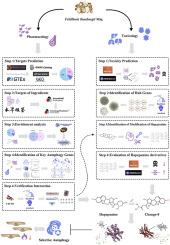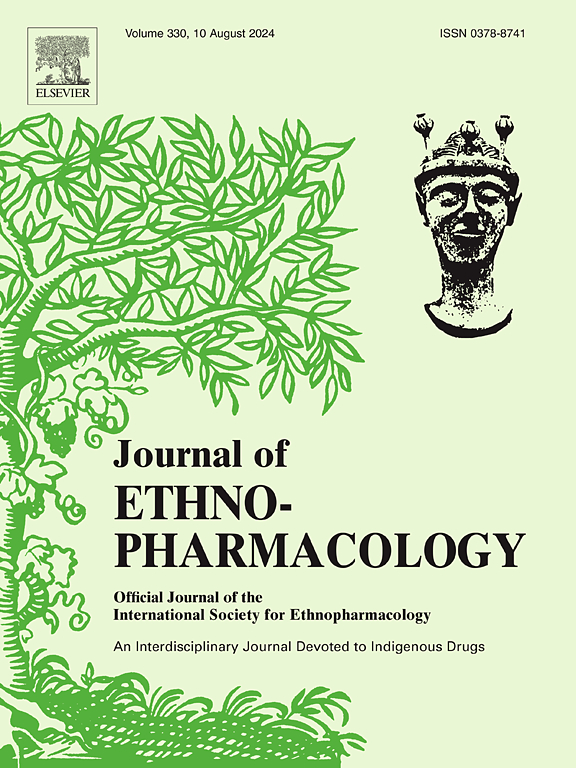Elucidating anti-triple-negative breast cancer mechanisms and mitigating toxicity of Fritillaria thunbergii Miq.: A multi-omics and network pharmacology approach
IF 5.4
2区 医学
Q1 CHEMISTRY, MEDICINAL
引用次数: 0
Abstract
Ethnopharmacological relevance
Fritillaria thunbergii Miq. (Zhebeimu, ZBM) is traditionally recognized in Chinese medicine for its effects of clearing heat, resolving phlegm, suppressing cough, detoxifying, dissipating nodules, and resolving abscesses—properties that align closely with the pathogenesis of breast cancer. Classical texts including Shennong Bencao Jing and Bencao Zheng document its historical use in breast cancer treatment.
Aim of the study
This study aims to evaluate the potential therapeutic mechanisms and safety profile of the traditional Chinese medicine ZBM against triple-negative breast cancer (TNBC) using in silico methodologies.
Materials and methods
This computational study integrated network pharmacology, machine learning, and single-cell RNA sequencing to systematically identify ZBM's bioactive components and potential targets against TNBC. Molecular docking and dynamics simulations were employed to characterize interactions between key compounds and targets, while network toxicology assessed potential toxicity risks.
Results
Our multi-omics approach identified 42 bioactive ZBM components and 148 potential TNBC targets. Among these, machine learning algorithms prioritized five key autophagy-related genes, with CXCR4 selected as the core autophagy-associated target for computational validation. Molecular simulations predicted strong binding between hapepunine and CXCR4. Meanwhile, subtype analysis at the single-cell level revealed that BL TNBC subtypes may be particularly sensitive to ZBM compounds. Network toxicology revealed potential hepatotoxicity/nephrotoxicity risks. These risks were computationally mitigated through structural optimization of hapepunine derivatives.
Conclusions
This study not only provides a novel mechanistic framework for ZBM's anti-TNBC activity but also demonstrates the utility of network toxicology coupled with structural optimization in proactively identifying and mitigating potential toxicity liabilities of natural product derivatives.

阐明浙贝母抗三阴性乳腺癌机制和减轻毒性:多组学和网络药理学方法。
民族药理学相关性:浙贝母。中药传统上认为,浙北木具有清热、化痰、止咳、解毒、散瘤、化脓的功效,这些特性与乳腺癌的发病机制密切相关。包括《神农本草经》和《本草征》在内的经典文献记录了它在乳腺癌治疗中的历史应用。研究目的:本研究旨在利用计算机方法评价中药中药中药中药中药中药对三阴性乳腺癌(TNBC)的潜在治疗机制和安全性。材料和方法:本计算研究结合了网络药理学、机器学习和单细胞RNA测序,系统地鉴定了ZBM的生物活性成分和针对TNBC的潜在靶点。分子对接和动力学模拟表征了关键化合物与靶点之间的相互作用,而网络毒理学评估了潜在的毒性风险。结果:我们的多组学方法鉴定出42种生物活性ZBM成分和148种潜在的TNBC靶点。其中,机器学习算法对5个关键的自噬相关基因进行优先排序,选择CXCR4作为自噬相关的核心靶点进行计算验证。分子模拟预测了喜普宁和CXCR4之间的强结合。同时,单细胞水平的亚型分析显示,BL TNBC亚型可能对ZBM化合物特别敏感。网络毒理学显示潜在的肝毒性/肾毒性风险。这些风险是通过计算减轻结构优化的五滨碱衍生物。结论:本研究不仅为ZBM抗tnbc活性提供了一个新的机制框架,而且证明了网络毒理学结合结构优化在主动识别和减轻天然产物衍生物潜在毒性方面的实用性。
本文章由计算机程序翻译,如有差异,请以英文原文为准。
求助全文
约1分钟内获得全文
求助全文
来源期刊

Journal of ethnopharmacology
医学-全科医学与补充医学
CiteScore
10.30
自引率
5.60%
发文量
967
审稿时长
77 days
期刊介绍:
The Journal of Ethnopharmacology is dedicated to the exchange of information and understandings about people''s use of plants, fungi, animals, microorganisms and minerals and their biological and pharmacological effects based on the principles established through international conventions. Early people confronted with illness and disease, discovered a wealth of useful therapeutic agents in the plant and animal kingdoms. The empirical knowledge of these medicinal substances and their toxic potential was passed on by oral tradition and sometimes recorded in herbals and other texts on materia medica. Many valuable drugs of today (e.g., atropine, ephedrine, tubocurarine, digoxin, reserpine) came into use through the study of indigenous remedies. Chemists continue to use plant-derived drugs (e.g., morphine, taxol, physostigmine, quinidine, emetine) as prototypes in their attempts to develop more effective and less toxic medicinals.
 求助内容:
求助内容: 应助结果提醒方式:
应助结果提醒方式:


